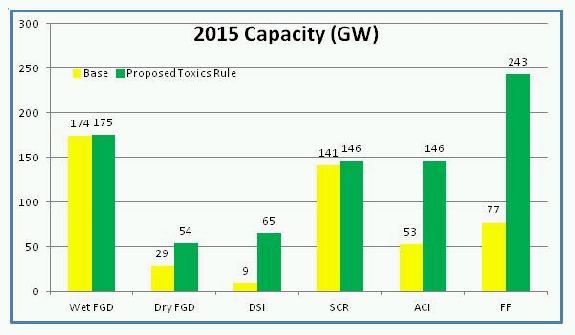On March 16, 2011, the U.S. Environmental Protection Agency
(EPA) proposed a rule (the EGU MACT Proposal) containing the first
national standards to reduce hazardous air pollutant (HAP)
emissions from new and existing coal- and oil-fired electric
utility steam generating units (EGUs). The EGU MACT Proposal
requires the application of maximum achievable control technology
(MACT), pursuant to Section 112(d) of the Clean Air Act (CAA). This
Commentary focuses on the proposed emission standards and
deadlines for existing EGUs.
The 1990 CAA Amendments required EPA to study EGUs and make a
determination whether they should be included in the list of HAP
emissions sources required to apply MACT. EPA submitted the study
to Congress in 1998 and, without notice and comment, listed EGUs as
a source category under Section 112(c) of the CAA two years later.
On March 29, 2005, EPA issued a final rule removing coal- and
oil-fired EGUs from the list of sources regulated under Section
112(c) of the CAA but adopting a mercury cap-and-trade rule for
EGUs under other CAA authority for HAP emissions regulation. On
February 8, 2008, however, the United States Court of Appeals for
the District of Columbia Circuit vacated this action, ruling it did
not comply with the delisting requirements of CAA Section
112(c)(9). State of New Jersey v. EPA, 517 F.3d 574, 578,
583 (D.C. Cir. 2008), cert. denied, 129 S. Ct. 1308,
cert. dismissed, 129 S. Ct. 1313 (2009). Section 112(c)(9)
allows EPA to delist source categories only if it first determines
that no adverse environmental effect will result, which EPA did not
do. Id. at 578–79. EPA subsequently entered a
consent decree requiring the EGU MACT Proposal to be issued by
March 16, 2011, with a final rule no later than November 16,
2011.
The EGU MACT Proposal addresses emissions of mercury and a variety
of other HAPs from EGUs. The chart below presents the EGU MACT
Proposal's numerical emission limits for mercury (Hg),
particulate matter (PM), and hydrogen chloride (HCl) for existing
coal-fired EGUs. EPA proposes that PM be a surrogate for various
HAPs (either as total nonmercury metals or as certain individual
nonmercury metals). HCl is a surrogate for toxic acid gases.
Alternate pollutants exist for each surrogate category. Total
non-Hg HAP metals and certain individual HAP metals are alternates
for PM. Sulfur dioxide (SO2) is an alternate for HCl.
The recommended controls in each category apply to all the
pollutants in that category.
| Pollutant(s) | Emission Limits (Existing Coal-Fired EGUs) |
Controls |
| Total particulate matter (PM) OR Total non-Hg HAP metals Individual HAP metals: Antimony (Sb) Arsenic (As) Beryllium (Be) Cadmium (Cd) Chromium (Cr) Cobalt (Co) Lead (Pb) Manganese (Mn) Nickel (Ni) Selenium (Se) |
0.030 lb/MMBtu
or 0.30 lb/MWh 0.000040 lb/MMBtu or 0.00040 lb/MWh 0.60 lb/TBtu or 0.0060 lb/GWh 2.0 lb/TBtu or 0.020 lb/GWh 0.20 lb/TBtu or 0.0020 lb/GWh 0.30 lb/TBtu or 0.0030 lb/GWh 3.0 lb/TBtu or 0.030 lb/GWh 0.80 lb/TBtu or 0.0080 lb/GWh 2.0 lb/TBtu or 0.020 lb/GWh 5.0 lb/TBtu or 0.050 lb/GWh 4.0 lb/TBtu or 0.040 lb/GWh 6.0 lb/TBtu or 0.060 lb/GWh |
Electrostatic precipitators
(ESPs) Fabric filters (FFs) Downstream secondary PM control device (e.g., secondary FF or wet ESP downstream of a wet flue gas desulfurization [FGD] scrubber) |
| Hydrogen chloride (HCl) OR Sulfur dioxide (SO2)1 | 0.0020 lb/MMBtu or 0.020
lb/MWh 0.20 lb/MMBtu or 2.0 lb/MWh |
Dry sorbent injection (DSI) Fluidized bed combustion (FBC) Slurry streams used in wet scrubber and dry spray dryer absorber FGD systems |
| Mercury (Hg) | 1.0 lb/TBtu or 0.008 lb/GWh (coal-fired unit designed for coal greater than or equal to | FFs Wet FGD scrubbers |
The EGU MACT Proposal's emission limits apply to EGUs as
defined in CAA Section 112.2 According to EPA estimates,
the EGU MACT Proposal will affect approximately 1,200 existing
coal-fired units and 150 oil-fired units at about 525 power plants.
In justifying the EGU MACT Proposal, EPA estimated that every
dollar spent on installing and operating the proposed emission
controls would result in $5 to $13 in health benefits, such as
preventing premature deaths, heart attacks, asthma attacks, and
days of missed work.
The chart above lists the recommended controls for each group of
pollutants. EPA believes that these control technologies are widely
available. According to EPA, more than half of all coal-fired power
plants already use one or more of the recommended technologies. It
remains to be determined if existing EGUs can install controls that
will meet all of the proposed limits simultaneously or whether the
proposed limits are not achievable in combination with each other.
The graph below, taken directly from EPA, compares retrofit
emission control installations on coal-fired capacity (by
technology) in a resource-planning model base case to the expected
installations under the EGU MACT Proposal in 2015, measured in
gigawatt (GW) capacity. These technologies can also reduce
emissions of substances in addition to the HAPs targeted by the EGU
MACT Proposal.

Source: Integrated Planning Model run by EPA, 2011.
Abbreviations:
FGD: Flue gas desulfurization (scrubber)
DSI: Dry sorbent injection
SCR: Selective catalytic reduction
ACI: Activated carbon injection
FF: Fabric filter
EPA agreed in a consent decree to issue the final MACT rule by
November 16, 2011. The EGU MACT Proposal sets a deadline for
compliance at three years after the date of the final rule's
publication in the Federal Register. The EGU MACT
Proposal, however, grants discretion to the permitting authority to
grant an additional year under the CAA. Under the EGU MACT
Proposal, existing sources must demonstrate their initial
compliance no later than 180 days after the compliance date. Among
other aspects of the EGU MACT Proposal, EPA is soliciting comments
specifically on the ability of affected sources to meet this
deadline.
EPA is also proposing to revise the new source performance
standards (NSPS) for EGUs. The NSPS would revise the standards new
coal- and oil-fired power plants must meet for particulate matter
(PM), sulfur dioxide (SO2), and nitrogen oxides
(NOx). On February 27, 2006, EPA promulgated amendments
to the NSPS for PM, SO2, and NOx. EPA was
subsequently sued on the amendments and on September 2, 2009, was
granted a voluntary remand without vacatur of the 2006 amendments.
The proposed revisions to the NSPS are in response to that
voluntary remand and will not generally apply to existing EGUs.
They cover construction of new facilities and reconstruction or
modification of existing facilities commencing after the
Federal Register publication date for the proposal.
EPA will accept public comments on the EGU MACT Proposal for 60
days following its publication in the Federal Register.
EPA will hold public hearings on the proposal in Atlanta, Chicago,
and Philadelphia. Details on the hearing dates and precise
locations will be available in a separate Federal Register
notice and at http://www.epa.gov/airquality/powerplanttoxics/.
The docket includes a significant amount of data collected by EPA
pursuant to an information request sent to EGUs that can be used to
analyze the proposal.
All affected EGUs should review the proposed standards to determine
whether the proposed emission limits are appropriate and
achievable. The proposed MACT standard applies to HAP emissions at
all EGUs. The proposed NSPS applies to certain projects that
commence construction after the Federal Register
publication date of the proposal. Aspects of the proposal that do
not receive comment during the 60-day comment period cannot
subsequently be challenged.
Footnotes
1. The alternate SO2 limit can be used only for coal-fired EGUs where wet or dry flue gas desulfurization technology is installed and will be operated at all times.
2. The CAA definition includes "any fossil fuel fired combustion unit of more than 25 megawatts that serves a generator that produces electricity for sale. A unit that cogenerates steam and electricity and supplies more than one-third of its potential electric output capacity and more than 25 megawatts electrical output to any utility power distribution system for sale shall be considered an [EGU]." CAA Section 112(a)(8).
The content of this article is intended to provide a general guide to the subject matter. Specialist advice should be sought about your specific circumstances.





